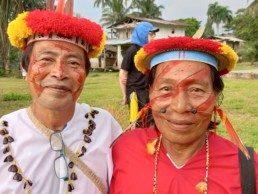1/4
Indigenous peoples own, use, or manage around 25% of the world's land surface, including areas with high biodiversity.
ICF supports efforts to defend the land rights of indigenous communities. Indigenous peoples are outstanding guardians of their land we align our goals with their traditional practices to achieve more sustainable outcome.
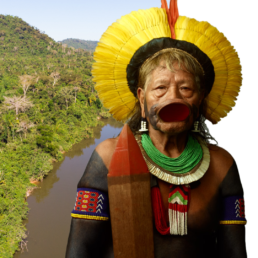
Photo: Martin Schoeller
The Kayapo
The Kayapo people are the living symbol of successful indigenous resistance. Also known as the Mebengôkre, they belong to the Jeê language family and are known for their rich cultural heritage, traditional way of life, and strong resistance against external threats to their lands.
Their fierce warrior skills and high levels of political organization have secured them constitutional rights over more than 9 million hectares of pristine tropical rainforest. Their land is situated at the frontlines of industrial development in the Southeast Amazon, but despite this, their border is holding strong, and their forests and rivers are wild and full of game. This is the result of the Kayapo-NGO alliance, one of the most successful and inspiring conservation stories of all time.
1/2
Indigenous Peoples manage or hold tenure rights over almost half of the of the earth’s protected areas.
Indigenous territories often harbor some of the world’s most biodiverse and pristine ecosystems. Protecting these areas contributes not only to local well-being but also to global biodiversity and climate change mitigation efforts.
The Yali
The Yali people are an indigenous group residing in the highlands of Papua, which is the western half of the island of New Guinea. They are part of the larger Dani ethnic group and are primarily found in the Yahukimo Regency in the Indonesian province of Papua. The Yali people have a distinctive culture, and their way of life is characterized by traditional practices such as agriculture, hunting, and gathering.
Like many indigenous groups, the Yali people face various challenges, including encroachment on their land, resource exploitation, and socio-economic pressures. Despite these challenges, they demonstrate resilience and efforts to preserve their cultural identity and protect their ancestral territories.

Photo: Ivan Rejon
5%
370 million indigenous people reside in more than 90 countries, constituting around 5% of the global population.
Indigenous communities often possess deep knowledge about their local environments, ecosystems, and sustainable practices. Collaborating with them allows ICF to tap into this wealth of traditional ecological knowledge, which can be invaluable in developing effective conservation and sustainable resource management strategies.
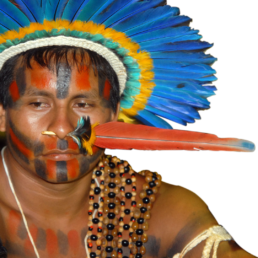
The Kulina
The Kulina, indigenous to the Amazon basin in Brazil and Peru, have a rich cultural heritage deeply connected to the rainforest. Historically semi-nomadic, they engage in agriculture, hunting, and gathering.
Residing alongside the Juruá and Purus rivers, the Kulina people stand out for their steadfast preservation of cultural traditions, including music and shamanic practices. An illustration of their commitment is evident in the fact that, despite prolonged interaction with outsiders and the proximity of some villages to urban areas, there is no knowledge of any Kulina individuals residing beyond their ancestral territories.
The Kulina’s spiritual beliefs are intertwined with nature, including spirits associated with the forest and rivers. Facing challenges from external influences, they strive to preserve their cultural identity and protect their lands. The Kulina express their artistic skills through creations reflecting their connection to the natural world.
340
Indigenous peoples and local communities, responsible for the care of certain regions, sequestered an annual amount of 340 million metric tons of carbon.
Indigenous communities are often the stewards of unique cultures and lifestyles closely tied to their environments. Working with them helps to preserve and respect these cultures, promoting a more holistic approach to environmental conservation and climate change mitigation that considers both the ecological and cultural dimensions.
The Wounaan
Wounaan of Panama have lived up and down the Pacific coast and rivers of the Choco – Darien Ecoregion for generations. Their territories border, buffer and provide critical habitat connectivity to Panama’s protected areas including the Darien National Park and World Heritage Site and the Bay of Panama Wildlife Refuge. Their communities are often located at the edge of the tidal reach between estuarine mangrove forests and semi-deciduous tropical moist forests. They catch fresh fish and shrimp and collect mangrove crabs and clams. They maintain diverse gardens, gather wild fruits and medicines, and plant bananas, plantains, corn and root crops in small forest clearings. Wounaan are world renowned for stunning wood carvings and baskets honoring plants and animals of their lowland tropical forests home. Yet, their remaining lands and waters are increasingly taken from them.
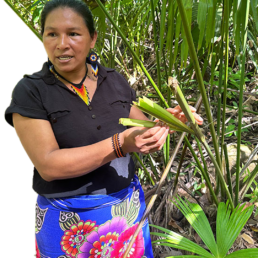
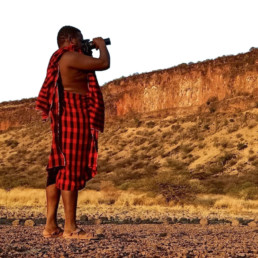
The Maasai
The Maasai are a semi-nomadic ethnic group inhabiting parts of Kenya and Tanzania in East Africa, renowned for their distinctive culture, including traditional attire featuring brightly colored clothing and intricate beadwork. ICF supports the Kenya Bird of Prey Trust’s mission to secure healthy raptor populations in Kenya. This partnership involves collaborating with Maasai property owners to establish a community wildlife sanctuary spanning 12,600 hectares along a 15-kilometer stretch of cliff habitat favored by breeding vultures and falcons, with plans to expand its size in the future.
The Siekopai
The Siekopai, or “people of many colors”, speak the language of Paicoca, part of the Tucanoan language group. They inhabit warmer lowland forests of Ecuador nearer the Peruvian border, overlapping the Cuyabeno Flora and Fauna Reserve. Their territory has been fragmented and they were displaced from their ancestral home, which they are fighting to reclaim. Affected by the Texaco-Chevron oil disaster, they live downstream from gold mining activity, and agrochemical runoff from vast palm oil plantations. The rivers they depend on for fish are no longer sustainable sources of food and drinking water. The Siekopai are highly knowledgeable about their forests and have effectively kept tens of thousands of hectares of forest intact against all odds. YAKUM has supported the planting of Siekopai food forests and territory mapping work since 2018.
